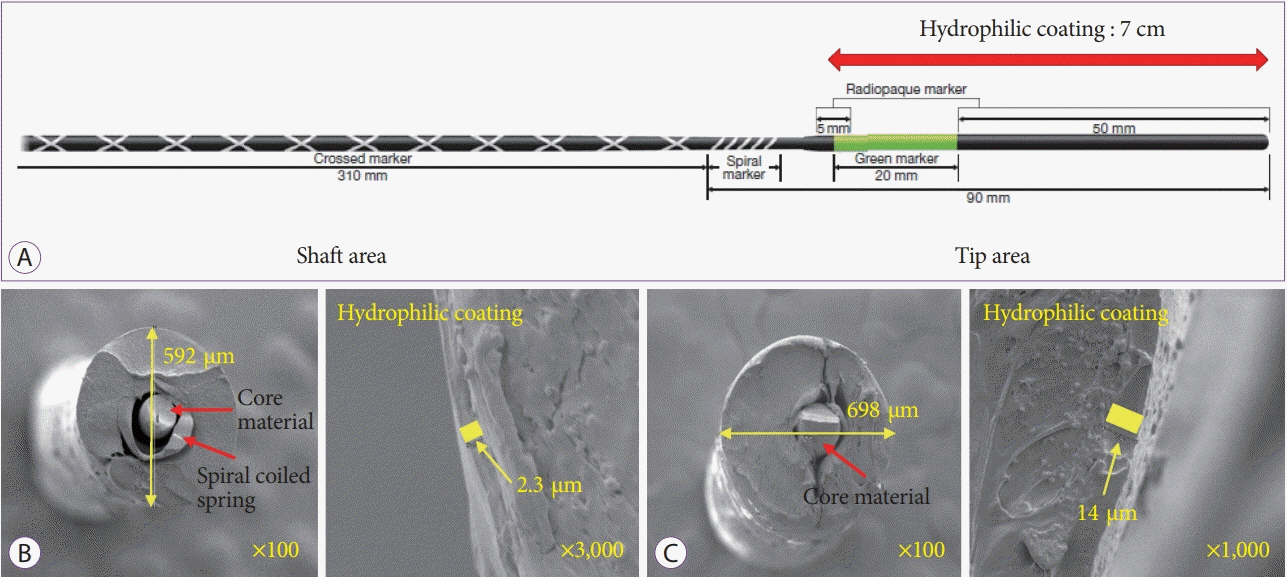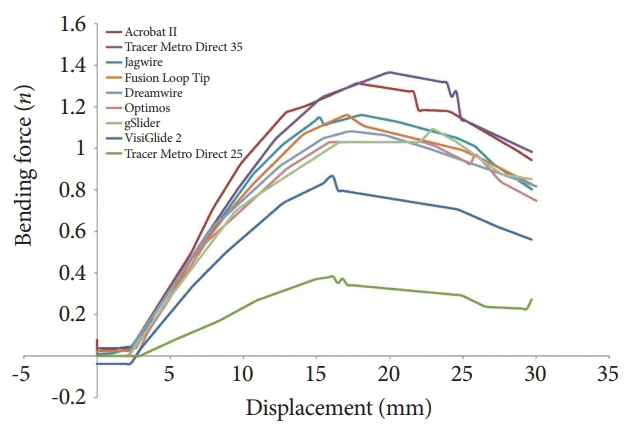INTRODUCTION
The guidewire is a cornerstone accessory in endoscopic retrograde cholangiopancreatography (ERCP). A guidewire helps achieve selective cannulation and traversal of irregular strictures in the bile and pancreatic ducts and supports accessory placement or insertion during various ERCP procedures [
1,
2]. Several reports have suggested that proper selection of a guidewire could increase the success rate of selective cannulation, and that the wire-guided cannulation technique could be superior to the contrast-guided cannulation technique in increasing the primary bile duct cannulation rate and reducing the incidence of post-ERCP pancreatitis [
3-
9].
The guidewire was originally developed to maintain access to common bile duct (CBD) during therapeutic procedures, but it is currently used to facilitate selective deep cannulation of CBD and to pass severe strictures. Manufacturers have also continued to introduce better functions for guidewires. Many varieties of guidewire are available in Korea, and their choice depends on the preference of the operator, the type of procedure, and the status and location of the disease. Also, guidewires from different manufacturers have different features; their performance depends on various basic features, such as thickness, tip shape, flexibility, stiffness, and hydrophilic coating [
1,
2]. Therefore, it is very difficult to distinguish performance abilities for diverse guidewires. It is also not easy to conduct prospective clinical studies that evaluate guidewires in specific situations, such as difficult cannulation, wire-guided cannulation, and hilar cholangiocarcinoma. Moreover, even if prospective clinical studies had progressed well, it is unreasonable to apply their results uniformly to all situations.
We conducted this technical study to introduce general details of currently available guidewires, investigate the characteristics of each guidewire type, and evaluate the efficiency and rapidity of insertion.
Go to :

DISCUSSION
In general, when we use new endoscopic accessories, we rely on the company’s official marketing report and marketing strategy to understand the product when it is launched. However, operators are exposed to the actual pros and cons of the product while using them for patients and often feel that there are some difference from the official report of the company. A product can also feel different depending on the operator’s technique and product preference. In this technical study, we tried to explain this gap more systematically. There are many limitations to conducting clinical studies with the purpose of obtaining an objective understanding of new product characteristics. Specifically, very expensive research costs, achieving similar patient conditions, and accounting for simultaneous use of different accessories are the biggest constraints. Rather than attempt to gauge which products are better, or what features a product may have, a technical study seeks to understand the reasons behind these product characteristics.
We conducted this study in order to elucidate the basic structure, basic properties, and materials used for currently available guidewires in Korea. In addition, we investigated the guidewires’ technical characteristics, focusing on their efficiency and speed of insertion. During this study, two problems presented a great burden to researchers. First, we could not compare the advantages and disadvantages of all guidewires, therefore we decided to compare only the insertion time and selective cannulation rate. Second, we were challenged in finding ideal tools to measure the guidewires objectively. We also had spent a great deal of time finding new methods that had not been reported previously. We thought that the most suitable material for
in vitro testing would be a silicone tube. A commercial silicone tube is simple, straight, and cylindrical with a constant diameter, and could be used in an
in vitro model. Therefore, we used 3D printing to produce silicone tubes in the special shapes we wanted (
Fig. 3). We were able to use the running direction, or the inner diameter of the lumen. However, unlike a commercial silicone tube, the silicone used in 3D printing is harder to use because it is transparent, and once formed in a biliary tree shape, it becomes too hard, and cannot be used in a technical study. Therefore, 3D-printed silicone tube models had to be made in straight shapes in order to carry out the technical study. At the same time, a separate model with a curved biliary tree was required to compare the selective cannulation ability of the guidewires. Therefore, we used simply-shaped and commercially-sold silicone tubes to make an in vitro biliary tree model. The tubes were attached to each other using a silicone bond (
Fig. 4). This model could not be applied to different strictures, but it could be made stereoscopic and semi-movable using Lego blocks, and the direction of the branches could be set as desired, which allowed it to be shaped like an actual biliary tree. This allowed us to test selective cannulation.
Tables 1 and
2 summarize the basic features of the guidewires used in this study and show that they have similar structures but very different configurations and technical properties. These fundamental differences are the result of trying to make the most ideal product through numerous
in vitro and
in vivo tests, which are unique to each company. However, from the point of view of selection, these features could not decide which guidewire to use. To further objectively measure this, we used two
in vitro models to test the insertion time and selective cannulation rate. As mentioned in the results,
Tables 3,
4, and
5 show different results for each guidewire. In terms of shaft thickness, there were no significant differences in the insertion time, but thin guidewires showed some better results in the frequency of insertion. However, in considering the bending force of the shaft, we found that a thin guidewire with a relatively high bending force tended to overcome all other parameters. Therefore, the shaft must be elastic to ensure forward axial transmission of forces [
1]. In terms of the shape of the tip, the angled shape was more effective for selectivity, and it also had some effects on time. Coincidentally, we think that the recently released products with a spiral-coiled spring at the tip were superior in all respects. The most important part of the guidewire configuration for biliary cannulation is the tip, and the new products are mainly focused on this part [
10,
11]. However, in order to ensure an objective evaluation, we believe that the research method should be more elaborate. More accurate results could be obtained if the research were conducted separately for each tip’s core material, coating, and shape, even for the same products.
The limitations of this study are as follows: (1) The testing environment was very different from a human body, since we relied on in vitro models and (2) Because of the limited testing environments, we could not perform the test on diverse kinds of guidewire. Indeed, even the same product could not be divided according to the shape of the tip. The greater the number of products used, the more difficult statistical analyses would become. (3) More skilled operators were unable to repeat the test more often. (4) Although we repeated the saline flushing due to the severe friction of the silicone tube, there were significant limitations to this approach. Filling the silicone tube with glycerin could have greatly reduced friction, but we did not do so, because we wanted to test the hydrophilic properties of the guidewires. (5) We could not investigate the tip bending force with a more sensitive measuring instrument, which could have provided information on the special features of spiral coiled springs at the tip area. Despite these limitations, to the best of our knowledge, our study is the first attempt at a technical study of guidewires. As mentioned earlier, we hope that this study will help readers to understand what features will bring out the benefits of guidewires, rather than gauge which guidewire is better.
In conclusion, among several types of guidewires, some factors (highly flexible and angled tip, and resilient shaft) could be associated with the efficiency and rapidity of the guidewire insertion.
Go to :









 PDF
PDF Citation
Citation Print
Print




 XML Download
XML Download